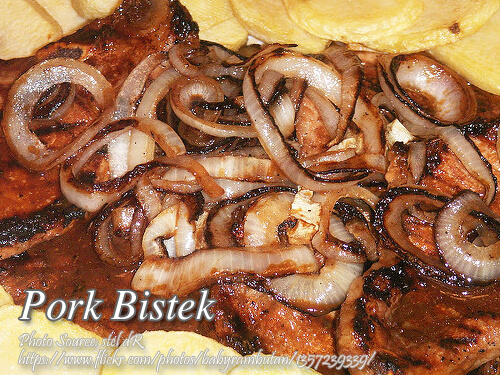This pork bistek recipe is a variation of the popular bistek tagalog which is made from thin slices of beef marinated in a mixture of soy sauce, calamansi juice (or lemon/lime juice) and spices. Then braised and simmered until tender. The pork version has almost the same ingredients and procedure on cooking the dish.
Just shorter time in cooking because pork tenderloin requires less time to tenderize compared to beef. Actually the word bistek came from the Spanish word bistec which means “steak”. But I’m not sure how it is assumed as “beef steak” but maybe because we are so influenced by American culture that we invented the word bistek as beef steak.
A Taste of Nostalgia: Cooking Pork Bistek Like Tita Fely’s
I remember the very first time I cooked it, as if it was yesterday. My Tita Fely-the kitchen magician-was introducing me to a flavorful and warm dish. It was in one of those family reunions where the house was full of the scent of sizzling meat and the tangy smell of calamansi. You’d hit the bottom of your stomach for a growling anytime you entered the house, although you weren’t hungry.
She called it her “Filipino-style steak,” but we all knew she was referring to the well-loved dish that has been passed down from one generation to another. It’s just like the old-fashioned bistek Tagalog, but with a twist. We use pork in cooking pork bistek instead of beef, and trust me, this version is just as delicious, if not more tender and juicy.
The Secret to the Tender Pork Bistek Lies in the Marinade
The first thing that came into my understanding is that the secret to good pork bistek is in the marinade. That’s according to my cousin Joel, who is always experimenting in the kitchen. He once told me that he likes to marinate the meat for at least two hours so that all those tangy, salty flavors and slightly sweet flavors are able to penetrate the pork deeply, so when you take that first bite, it explodes with flavour.
The soy sauce, calamansi juice, and liquid seasoning-those are of course with a little Worcestershire sauce for that extra oomph-and all these together balance that sour, salty, and savory. And then, of course, there’s the garlic-my brother puts in a little bit more because he said it makes the dish warm and comforting.
This step is most important but the beauty of using pork tenderloin is that it doesn’t require as much time to become tender like beef; you will save some time in this aspect, making it perfect for a quick family meal on busy weeknights. Yet, despite the comparative shorter cooking time, the dish still makes its punch in flavor.
A Brief History: From Spanish Bistec to Filipino Bistek
I did not know that the word bistek actually came from the Spanish term bistec, meaning “steak.” That really got me curious when my Lolo Ignacio shared that information with me. He added that in the old days, the Spaniards introduced their version of steak to the Philippines and eventually made it a Filipino favorite.
Somewhere along the way, we had managed to associate bistek with beef more so because of an American taste imprint. But as most of us are aware, pork is equally dominant in Filipino dishes, much more so because it was cheaper and accessible. And this pork version embodies exemplarily how we made foreign influences fitting only within an unique flavor profile of our own.
How to Cook Pork Bistek Meat: Sizzling Perfection
When you’re ready to cook the pork bistek, the first thing you do is sauté the onions until they are soft and somewhat caramelized. I used to skip this step when I was just starting out. I thought that didn’t matter. My sister Carla used to remind me how important that step was. Onions add sweetness to the meat but more importantly make the savory flavors out of the meat. After the onions are cooked, set them aside because you’re going to use them for garnish later.
Then comes the fun part-frying the marinated pork until it turns into a beautiful golden brown. The sizzling sounds when the pork hits the hot oil are music to my ears as I reminisce about those weekends during my lunch hours with cousins and how we would wait for the first taste right around the kitchen. As the pork browns, it releases all the flavors it absorbed while marinating.
Then you add the marinade and dilute it with a small amount of water or broth. Now it all flows. Allow it to stew until the meat is tender, almost a fall-apart meat piece, which is usually the case after 45 minutes of stewing. If you have liquid cooking out faster than this, and pork isn’t even tender yet, you can always add some more water. My Tito Nestor likes his sauce to be quite thick and heavy, so he keeps it on a slow simmer, occasionally stirring and until the flavors are just right.
Final Strokes: All Balance
Before serving, you have to season it right. My mom always reminds me of tasting the sauce before I plate it, like giving it the last test taste to see if all the flavors go well. Sometimes, depending on the soy sauce or calamansi, you might have to add a bit more salt or sugar just to get that right balance.
Finally, place the sautéed onions on top of the pork. The sweetness of the onions blends well with the savory flavor of the meat, and they actually make the dish look much more appealing. It’s a slight touch, but it makes the whole experience worth it.
A Dish for All Occasions
Whether it’s cooked to satisfy the family or just as an after-work meal, this Filipino-style steak always hits the spot. So many good memories for me—of family and how much fun we had, all of it with laughter and joint love for food.
I remember well the first time I served pork bistek to my own family, though. Daughter Mika said it tastes just like her Lola made it. Let’s just say that made me smile because after all, that is what cooking is about: passing recipes, sharing stories, and weaving memories around the dinner table.
And this dish, despite being easy, is very historical in flavor. So, whether you’re a beginner or an experienced cook, I hope this recipe brings you as much joy as it has brought me and my family.
How to Cook Pork Bistek
Ingredients
- 1/2 kilo pork tenderloin sliced thinly about half inch thick
- 4 Tbsp. soy sauce
- 8 pcs calamansi (extract the juice)
- 2 Tbsp. liquid seasoning or Worcesteshire sauce
- 1 cup beef broth or water
- 4 Tbsp oil
- 1 pc big onion sliced into rings
- 5 cloves garlic minced
- 1 tsp. sugar
- 1/2 tsp. ground pepper
- MSG to taste optional
Instructions
How to cook Pork Bistek:
- Marinate the pork slices in soy sauce, calamansi juice, liquid seasoning or Worcestershire sauce, garlic, sugar, ground pepper and MSG for about 2 hours.
- Heat some oil in a pan and saute onions until soft and set aside.
- In the same pan, add more oil and stir fry the marinated pork until brown. Then add the marinade, soup stock or water and simmer for 45 minutes or until the pork is tender. Add more water is the pork is not yet tender and the liquid dries up.
- Adjust the seasoning if needed and add the onions as garnishing then serve hot.
Video
Notes
Cooking Tips of Pork Bistek:
Marinate for Maximum Flavor
Allow the pork to marinate for at least two hours; otherwise, the soy sauce and calamansi juice's flavor and spices that would be infused into the meat may not go well. The more extended the marinating time is, the better the tangy and savory notes would blend with the pork for each bite to be equally savory. Finally, to achieve the best possible results, it is best if the pork sits overnight in the refrigerator. This way, the taste will be much stronger.Do Not Overcook the Pork
Since pork tenderloin cooks faster than beef, be watchful not to overcook it. Once the pork develops its brown color and the sauce has reached the desired thickness, start checking several times so it does not get mushy. Simmering this far will give you the melt-in-your-mouth texture by the help of softening meat without drying or juicing.Caramelize the Onions
For the flavor of caramelized onions, it's best to cook them just until soft and slightly golden. Its sweetness cuts across the salty, tangy sauce for a perfectly balanced finish for the dish. Some of the cooked onions are set aside for garnishing, which adds an even more mouthwatering quality and attractiveness to the dish when ready to be served.





